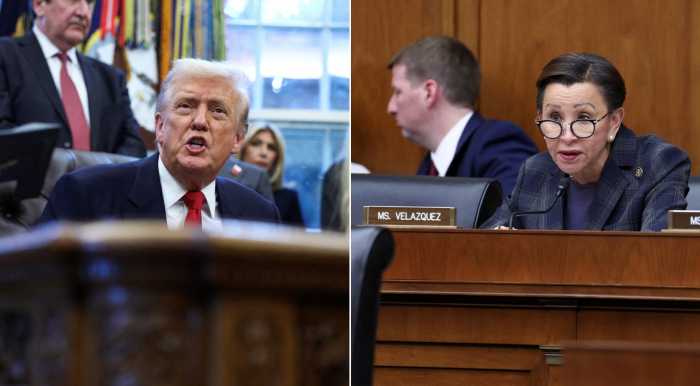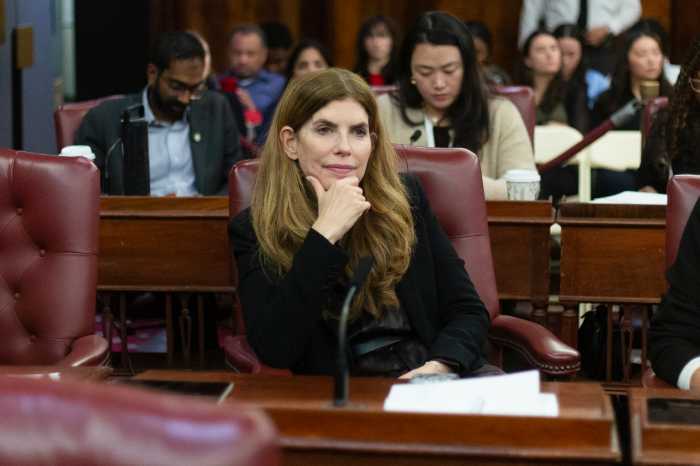Hollywood celebrates Ethel Barrymore’s 70th birthday at George Cukor’s palatial home, with (standing l. to r.) Billie Burke, Judy Garland, Lucile Watson, Katharine Hepburn, Constance Collier, and Laura Harding, and (seated l. to r.) Lionel Barrymore, the birthday girl, Spencer Tracy, and the director-host. | TUMBLR.COM
For some reason, in America, his own country, George Cukor never made it into the pantheon of directors universally considered great. The omission is scandalous when you consider the number of titles in his oeuvre that are undisputed classics. Although the late Andrew Sarris and the French espousers of the auteur theory, in which the director is everything, gave him props, his career’s lack of a recognizable “signature” — like John Ford’s Westerns, Hitchcock’s suspense, or Howard Hawks’ male bonding — has always made his name something of an afterthought to theirs.
Anyone planning, as I am, to immerse themselves in the Film Society of Lincoln Center’s complete retrospective, “The Discreet Charm of George Cukor” — a holiday treat if e’er there was — will see at once how much this director deserves proper recognition at last. Katharine Hepburn, whom he helped discover and with whom he enjoyed a lifelong personal and professional relationship, once observed that Cukor’s signature was actually the performances of the actors in his films, which were always as good as they could possibly be.
There’s truth in that statement, but it’s somewhat of a simplification and diminishment, because Cukor also insisted on his scripts being as finely honed as possible. Similarly, he demanded that the look, the design of his films be elegant and apropos of their theme. He was fortunate to enjoy the lavish resources of MGM, the studio with which he was most associated, and it’s telling that, especially in the 1940s and ‘50s, when that company’s films became ever more hollow, even if luxuriously produced, Cukor’s output — “The Philadelphia Story,” “A Woman’s Face,” “Gaslight,” “Adam’s Rib,” “Pat and Mike,” “The Actress” — remained strong, particularly because of his respect for good writing.
Lincoln Center hosts an astonishing Cukor full career survey
What all of his films had in common was their elegance, a quality achieved as well by his fellow directors Max Ophuls, Ernst Lubitsch, and Vincente Minnelli, all of whom rank somewhat higher in critical estimation. And, if he had anything else that could be deemed a signature, it was the blessed lack of anything embarrassing in his work. There was nothing of the low, racist touches that marred Ford’s films, or Hitchcock’s use of unappealingly stiff or downright inept actors (Robert Cummings, John Forsythe, Gregory Peck, Vera Miles, Tippi Hedren), or Hawks’ increasingly heavy-handed, bumptious humor (“Monkey Business”, “I Was a Male War Bride”), fortunately absent in his earlier masterpieces like “Twentieth Century,” “Bringing Up Baby,” and “His Girl Friday.” Minnelli’s films may have looked gorgeous, but to bask in their aesthetic one often has to put up with a lot of shoddy, crassly commercial screenwriting. Simple good taste may not be all, but it is surely something.
Another reason for Cukor’s lack of appreciation may simply be homophobia. In a Hollywood macho to the core, he was the only big director who was unapologetically gay, and there is no more illustrative anecdote than the time his concerned boss, Louis B. Mayer, summoned him to his office and asked him point blank, “Are you homosexual?” Cukor’s reply: “Devotedly.” Unlike bisexual or rumored-to-be-so directors like Minnelli and Mitchell Leisen, he never felt the need to marry, and he remained on contract to MGM for nearly a quarter century. Critics have often dismissed him as a “women’s director,” which often is little more than a condescending code word for “gay” — and also highly specious when you consider that Spencer Tracy, Leslie Howard, John Barrymore, Fredric March, Wallace Beery, Lowell Sherman, and James Mason did some of their best work for him. Cukor literally taught Jack Lemmon how to act on screen and was the first director to really bring out the comic talent of Cary Grant, hitherto a failed matinee idol. Basil Rathbone, hitherto a successful matinee idol, was so good as Mr. Murdstone in “David Copperfield” that he found himself unhappily typecast as villains for the rest of his career.
Born George Dewey Cukor in New York City on July 7, 1899 to Jewish Hungarian parents, he was stage-struck from childhood, when divas like Nazimova, Ethel Barrymore, and Hazel Dawn dazzled him, engendering an undying love for theatrical ladies. He started on the lowest rungs of the business, working in regional companies before gaining the status of Broadway director in the 1920s, doing the first stage adaptation of “The Great Gatsby.” The talkies in 1929 lured many New York stage types to the Left Coast, and he started as a dialogue director. His first big success was the film version of the “The Royal Family of Broadway” (1930), and he consolidated that with the stunning all-star achievement of “Dinner at Eight” (1933), which he finished in an amazing 27 days. For the rest of his career, smoothly handsome film adaptations of plays, like those two George S. Kaufman-Edna Ferber works, would be his particular métier.
Besides a bustling career, Cukor had an intriguing private life as one of Hollywood’s great hosts. He built a mouthwateringly palatial home in Beverly Hills, which saw many a party, as well as regular renters for its guest houses like Hepburn and Tracy (who actually passed away there). Two parties, in particular, memorably featured Judy Garland, who would find her screen apotheosis in Cukor’s masterpiece, “A Star is Born.”
The first was Ethel Barrymore’s 70th birthday party, when all fell silent and Garland sang “Happy Birthday” to her a cappella. ‘It was to die,” Hepburn later reminisced.
The second event is a hitherto unpublished anecdote I discovered while researching Cukor at the USC library, from an oral history, in which he described a party thrown for the all-black cast of Samuel Goldwyn’s “Porgy and Bess.” Garland was to entertain that night and Cukor asked her what she was going to sing. “Oh, ‘Swanee,’ ‘Mammy,’ ‘Rockabye Your Baby with a Dixie Melody,’“ she replied. Horrified, Cukor remonstrated that perhaps the guests would take offense, and was reassured by Garland that it would be all right. At the party, she indeed sang those songs, which were greeted with tumultuous applause and enthusiasm from all present. Catching her afterwards, Cukor started to apologize for his misgivings, but Garland cut him off, “You didn’t have to worry, George. The niggers love me!” True story, from the lips of Cukor, and illustrative of Garland’s famed correctness-be-damned attitude. (When I once repeated this story to her daughter Lorna Luft, she said simply, “Oh, dear.”)
The Lincoln Center program includes all of his biggest hits — the remarkable ten films he made with Hepburn, including perhaps his very best, the sparkling society comedy “Holiday,” and their notorious, gloriously self-indulgent flop, “Sylvia Scarlett,” one of the most bizarrely androgynous efforts to come out of the studio system. It features Hepburn impersonating a boy through much of it, gleaning the carnal attentions of both Dennie Moore and Cary Grant (who says that she/ he would make a “right good hot water bottle” to cozy up to in bed on a cold night), as well as in-jokes like the great cameraman Joseph August appearing as an extra and bisexual international beauty Natalie Paley bragging about having her picture taken by “Oliver [Messel] and Cecil [Beaton].”
There’s also that eternally watchable gay favorite, “The Women,” with its all-star all-female cast; the superb period noir “Gaslight”; “David Copperfield,” a classic made of a classic if there ever was one; “Girls About Town,” the very best 1930s gold digger comedy;
‘What Price Hollywood?,” the 1932 original version of “A Star is Born,” striking for its early dissection of the vicissitudes of Lotusland and marvelous Slavko Vorkapich’s montage of alcoholic director Lowell Sherman’s suicide; and “Camille” (1937), which is always celebrated as Garbo’s greatest vehicle, but should also be recognized as a great film in its own right. It’s a remarkable, opulent evocation of Dumas’ Second Empire Paris — and an absolute touchstone for every subsequent film or theatrical presentation of both the original play and Verdi’s opera of it, “La Traviata.”
Cukor’s magnum opus, “My Fair Lady,” for which he finally won a Best Director Oscar, is, ironically, one of his weakest films. He narrowly beat out Minnelli to direct it and, for once, I wish Minnelli had won, for the cinematic, pictorial verve and movement he might have lent to this too respectful, at times downright stodgy movie transfer. The awful dubbing of Audrey Hepburn’s perfectly adequate (if not Melba-esque) voice aside, she yet manages to be enchanting, but Rex Harrison’s performance is mummified and his cavorting at Ascot may be the most badly acted moment in all Cukor.
The rarities here are what will fascinate hard-core cinemaniacs. “Zaza,” written by a frequent Cukor collaborator, the literate and lyrical, possibly bisexual Zoë Akins, is an eye-poppingly lavish Paramount Belle Epoque fantasia, featuring Claudette Colbert in perhaps her richest performance, as a cabaret star thrown by her love for a married man (Herbert Marshall). A rare bit of profound miscasting for Cukor, Marshall is ineffably dull and unalluring, but Colbert is astonishing, going from a music hall hoyden, flamboyant enough to have been written by Colette, to piercingly delicate Back Street heartbreak, and the cabaret/ backstage scenes are charged with a fabulous brio.
In 1936, producer Irving Thalberg hired Cukor to bring “Romeo and Juliet” to the screen, starring his wife Norma Shearer and Leslie Howard. They were both well over 30, and this fact, for years, has been the misguidedly negative focal point in consideration of the film. Cukor himself felt that it was a little too reverentially staid and could have used some of the garlic and fire of the Zeffirelli 1960s version, but I think it is quite extraordinary. Photographed by the great William Daniels and designed by Oliver Messel, it’s one of the most beautiful black and white films ever made and is perfectly cast, down to the smallest part, with John Barrymore, as Mercutio, giving a real demonstration of what made him the leading actor of his generation. Even with her inescapable affectations, Shearer makes a radiant and eventually moving Juliet (especially in the potion scene, done in one long, extraordinary take, a Cukor specialty), and velvet-voiced Howard has that singular, essential quality usually lacking in Romeos — true nobility.
“Two-Faced Woman” and “Her Cardboard Lover” have forever been categorized as demeaning swan songs for those MGM queens, Garbo and Shearer, but both are far from shameful. The first may have been messed up by the Hays Office for its adulterous theme, but has moments of S. N. Behrman-scripted genuine high comedy involving Garbo joyously sending up her own femme fatale image, and an ultra-delicious, acidic Constance Bennett. The second is a disarmingly soignée boudoir comedy based on a Jacques Deval stage vehicle once favored by Laurette Taylor, Jeanne Eagels, and Tallulah Bankhead and, with Cukor deftly guiding Shearer and her priceless playmate George Sanders through their aristocratically absurd paces, you can still see why.
“The Chapman Report” (1962) was Cukor’s darker version of “The Women,” based on a bestseller that took its inspiration from the sex-driven Kinsey Report. It features Shelley Winters as a discontented housewife going in for adultery, Glynis Johns as an arty socialite having a May-December fling with a beach boy, Jane Fonda as the frigid one, and Claire Bloom giving a spectacularly complex and tragic portrait of the nymphomaniac Naomi Shields. Yes, it’s every bit as entertaining as it sounds and, in my research, I was amused to find memos from producer Darryl F. Zanuck wondering what the hell was taking Cukor so long to film the beach scene of semi-nude hunks like Ty Hardin playing volleyball.
Yes, although Cukor was always extremely discreet and the ultimate professional, one cannot help noticing the plethora of comely male pulchritude in his films (something they share with those of his contemporary Luchino Visconti). It can be as obvious as in “The Chapman Report,” or materialize as that cadre of gorgeous soldiers who surround Judy Holliday at the climax of the effervescent “It Should Happen to You.” Cukor’s “type” is also obvious — he preferred the sun-kissed, Irish/ WASPy boys next door familiar from Bruce Weber shoots, and many of them would show up as his houseguests, the day after those grand soirees with Hepburn and Barrymore, to eat the leftovers, swim in his pool and… All this and Cukor himself were immortalized, however crassly, in “Gods and Monsters,” ostensibly a film about James Whale, another gay director, who like Minnelli, the competitive Cukor always disdained.
A rare moment of indiscretion once got him arrested on a vice charge, but MGM managed to erase both the particular charges and all subsequent record of it. He directed his final film, “Rich and Famous,” in 1981 at the astonishing age of 82, and it’s a fantastically funny, moving, and literate finale, with Jacqueline Bisset and Candice Bergen giving the performances of their careers as eternal frenemies who both write for a living. It also contains the most daring scene of Cukor’s career, in which Bisset picks up a succulent street hustler (Matt Lattanzi) and brings him to her hotel room where he drops trou and reveals possibly the most spectacular male caboose in cinema history. After seeing it, Hepburn declared, “George! You’ve made a very sexy movie!”
Cukor died in 1983, leaving almost everything to lawyer George Towers, a younger man he became involved with in the 1950s, and whose education he financed. His fabulous house was sold and its fabled William Haines-designed interiors renovated, but, boy, if those walls could only talk!
THE DISCREET CHARM OF GEORGE CUKOR | Film Society of Lincoln Center | Elinor Bunin Munroe, Film Center, 144 W. 65th St. | Walter Reade Theater, 165 W. 65th St. | Dec. 13-Jan. 7 | $10; $7 for students, seniors & members; $25 for five-film package at filmlinc.com


















